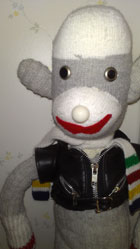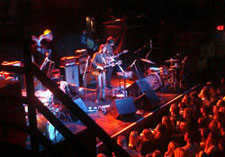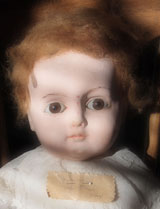| Beach Lane Books |
| ages 8 to 12, grades 3 to 7 |
| order this book |
| order the e-book: Kindle or Nook |
The Secrets of Eastcliff-by-the-Sea:The Story Behind the Story
by Eileen Beha
 |
|
| Martin Dosh's sock monkey | |
If an adoring fan hadn’t given indie-rock star Andrew Bird and each of his three band members a hand-sewn sock monkey fashioned in their likenesses, The Secrets of Eastcliff-by-the-Sea might never have been written.
At the time, my son-in-law Martin Dosh, a percussionist and keyboard man, was touring extensively with Andrew Bird, whose best-selling album to date, Armchair Apocrypha, had recently been released. Tango: The Tale of an Island Dog, my first novel for middle-grade readers, was about to be published, and I was looking for a new story idea.
Martin brought his sock monkey home to Minneapolis and gave it to my grandson, Naoise. The sock monkey was made out of a gray, white and red men’s work sock. He wore a zippered, black leather vest and had a multi-colored striped scarf wrapped around his neck.
 |
|
| Andrew's sock monkey and Stephen Colbert | |
Andrew Bird didn’t take his sock monkey home. Andrew’s sock monkey—dressed in a suit, tie, and Converse tennis shoes—went on tour with the band. Soon the sock monkey appeared on stage during every live performance as well as on television: the Late Show with David Letterman, the Tonight Show with Jay Leno, Jimmy Fallon, and the Colbert Report.
Whenever I was in the audience, I was captivated by the little sock monkey. He sat on a speaker stack, a double horn speaker spinning above his head. Inspired by the sock monkey’s endearing smile, I asked myself, “What if I wrote a story about a hand-sewn sock monkey who goes on tour with a rock band?”
 |
|
| Andrew Bird at First Avenue, Minneapolis | |
“What a great idea,” I thought. “So fresh . . . so original . . . kids will love it!” The title of my new book immediately came to mind: Sock Monkey, Rock Monkey.
Alas, transforming my inspiration into a compelling narrative for young readers proved to be far more difficult than I could have ever imagined.
I spent more than a year generating hundreds of pages of shapeless text, a writing exercise that Anne of Green Gables author L. M. Montgomery once called “spade work.” But no matter how many characters I conjured, how much back story I imagined, or how often I followed a new plot line, I couldn’t unearth the central conflict and deep thematic strands necessary to drive the story forward.
The turning point finally came during a writer’s workshop when my dear friend and writing mentor, Jane Resh Thomas, asked me two questions: “What is your story about at its deepest level?” and “Where are YOU in this story?”
I shrugged my shoulders, unable to respond.
Why? Because I didn’t know.
Not long after, I realized that the story of a sock monkey who travels with a contemporary indie-rock band was not my story to tell; it was Andrew Bird’s story.
My story, I decided, would take place in the past, not the present. My sock monkey, Mr. Throckmorton S. Monkey, would be created by the matriarch of a large and wealthy family, not a fan. My sock monkey would belong to a young girl named Annaliese whose heart’s desire was stronger than any dreams of stardom. My sock monkey would experience a brief and shining moment in the spotlight for reasons that brought neither fame nor fortune.
 |
|
| My Name is Ida Mae | |
Now, more than six years later, I can see many threads of my own life woven into the story both consciously and subconsciously.
Annaliese’s yearning for the mother that she never knew is one such strand, a yearning that was passed down to me from my own mother.
During the influenza epidemic of 1918 when my mother, Marcella, was five years old, her mother died. Rejected by her father and his new wife, Marcella and her two sisters were raised by their mother’s sister, my Great-Aunt Ida. Even as a small child, I understood how much my mother grieved the loss of her own.
Before she died in 2007, my mother pinned a scrap of paper, edges trimmed by a pinking shears, to the white muslin dress of a brown-eyed doll with a bisque head and gangling, sawdust-stuffed body.
Marcella’s two-sided note reads:
My name is Ida Mae (over).
Aunt Ida Hohensee was my caregiver at one time.
Love her (the doll) as I did love Aunt Ida.
 |
|
| Eileen and Ida Mae | |
To this day, Great-Aunt Ida’s doll is one of my prized possessions. She sits in a child-sized rocking chair in my writing studio and cradles an antique baby doll in her arms. Ida Mae is a daily reminder not only of my mother, but also of the great pleasure my favorite dolls (most of which I still have) gave me during my own childhood.
In The Secrets of Eastcliff-by-the-Sea, through the act of reimagining and the power of storytelling, my mother’s lifelong yearning merged with the heartfelt longings of a young girl named Annaliese. And somehow, in some small way, I feel that I have finally reunited Marcella with the one person that she most longed to know.